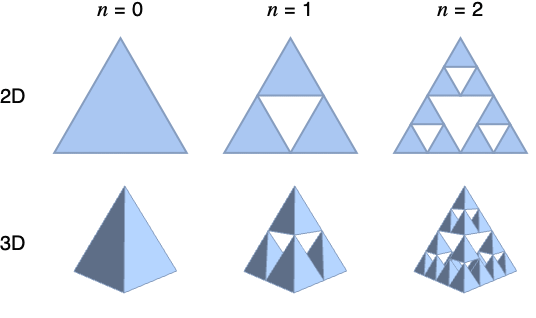gives a mesh region representing the n![]() -step Sierpiński triangle.
-step Sierpiński triangle.
SierpinskiMesh[n,d]
gives the n![]() -step Sierpiński sponge in dimension d.
-step Sierpiński sponge in dimension d.




SierpinskiMesh
gives a mesh region representing the n![]() -step Sierpiński triangle.
-step Sierpiński triangle.
SierpinskiMesh[n,d]
gives the n![]() -step Sierpiński sponge in dimension d.
-step Sierpiński sponge in dimension d.
Details and Options

- SierpinskiMesh is also known as Sierpiński triangle and Sierpiński sponge.
- SierpinskiMesh[n] is generated from a triangle by repeatedly removing the middle triangle of the subsequent cells. »
- SierpinskiMesh[n] is equivalent to SierpinskiMesh[n,2].
- SierpinskiMesh takes the same options as MeshRegion, with the following additions:
-
DataRange Automatic the range of mesh coordinates to generate

Examples
open all close allBasic Examples (2)
Options (12)
DataRange (1)
DataRange allows you to specify the range of mesh coordinates to generate:
MeshCellHighlight (2)
MeshCellHighlight allows you to specify highlighting for parts of a SierpinskiMesh:
MeshCellLabel (2)
MeshCellLabel can be used to label parts of a SierpinskiMesh:
MeshCellMarker (1)
MeshCellMarker can be used to assign values to parts of a SierpinskiMesh:
Use MeshCellLabel to show the markers:
MeshCellShapeFunction (2)
MeshCellShapeFunction can be used to assign values to parts of a SierpinskiMesh:
MeshCellStyle (2)
MeshCellStyle allows you to specify styling for parts of a SierpinskiMesh:
Applications (1)
SierpinskiMesh is generated from a triangle by repeatedly removing the middle triangle of the cells:
Properties & Relations (5)
The output of SierpinskiMesh is always a full-dimensional MeshRegion:
SierpinskiMesh consists of triangles in 2D:
Find the volume of the Sierpiński mesh in 3D at each stage:
Find the boundary mesh region of SierpinskiMesh:
DataRangerange is equivalent to using RescalingTransform[{…},range]:
Use RescalingTransform:
Possible Issues (1)
SierpinskiMesh can be too large to generate:
See Also
Related Guides
History
Text
Wolfram Research (2017), SierpinskiMesh, Wolfram Language function, https://reference.wolfram.com/language/ref/SierpinskiMesh.html.
CMS
Wolfram Language. 2017. "SierpinskiMesh." Wolfram Language & System Documentation Center. Wolfram Research. https://reference.wolfram.com/language/ref/SierpinskiMesh.html.
APA
Wolfram Language. (2017). SierpinskiMesh. Wolfram Language & System Documentation Center. Retrieved from https://reference.wolfram.com/language/ref/SierpinskiMesh.html
BibTeX
@misc{reference.wolfram_2025_sierpinskimesh, author="Wolfram Research", title="{SierpinskiMesh}", year="2017", howpublished="\url{https://reference.wolfram.com/language/ref/SierpinskiMesh.html}", note=[Accessed: 10-December-2025]}
BibLaTeX
@online{reference.wolfram_2025_sierpinskimesh, organization={Wolfram Research}, title={SierpinskiMesh}, year={2017}, url={https://reference.wolfram.com/language/ref/SierpinskiMesh.html}, note=[Accessed: 10-December-2025]}